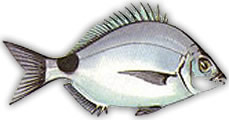How to catch Blacktail (Dassie/Kolstert) - Blacktail (Dassie/Kolstert) fishing tips
| FEEDING HABITS OF BLACKTAIL (DASSIE / KOLSTERT) ON THE NAMIBIAN COAST |

|
COMMON NAME: |
Blacktail, Cape White Seabream (Afr: Dassie, Kolstert - Deutsch: Große Geißbrasse)
|
LATIN NAME: |
Diplodus Sargus Capensis
|
DESCRIPTION: |
The head and body of the blacktail is usually silvery and there is a black blotch on top
or on the side of the peduncle below the rear end of the dorsal fin. Large adults are almost
uniformly black while juveniles have 8-10 faint black bars dorsally on the body. Adults also
show dark bars at night. Blacktail from Namibia are generally bigger than South Africa fish and
often have yellowish flecks on the body.
Blacktails north of Cape Vidal and Sodwana Bay are smaller (rarely over 30cm fork length)
and the black blotch is mostly on the side of the peduncle.
|
DISTRIBUTION: |
Southeast Atlantic and Western Indian Ocean: Angola to Mozambique and southern Madagascar,
possibly reaching Mauritius.
|
HABITAT: |
Tropical - 35°S - reef-associated, brackish, marine.
Blacktail is normally found inshore in shallow rocky areas and sandy substrate with high turbulence.
Also living freely in estuaries. Juveniles in shallow reefs, estuary mouths and intertidal pools, sandy beach surf zone.
|
REPRODUCTION: |
Like some other members of the Sparidae family, dassies change sex periodically.
Spawning takes place throughout the year, but more often in winter and spring.
|
SEASONAL MOVEMENT: |
?
|
FEEDING / DIET: |
Omnivorous on seaweeds, sponges and bivalves.
Also feeds on crustaceans, worms, mollusks, and fish.
It is a persistent feeder.
The feeding habits and alimentary canal of the blacktail changes with age, from a short gutted
carnivore to an omnivorous adult with a longer intestine better suited to digesting plant material.
Juveniles of 2-3cm standard length eat copepods, polychaete worms, amphipods, insect
larvae, etc. Juveniles over 5cm feed on algae, echinoids anthozoans, sponges, bivalves and
tunicates. The juveniles feed on the vertical surfaces of gullies. At night blacktail hover
in midwater or rest on the bottom.
|
WEIGHT: |
Avg 1.6 kg / published 3 kg (SA Record)
|
MAX SIZE: |
45cm TL - 3kg in 21+ years (avg 25cm).
|
DEPTH RANGE: |
25m
|
CAPTURE: |
During the winter (see Best time to catch Blacktail).
|
ROD: |
?
|
LINE: |
?
|
HOOK: |
No 2 (light tackle)
|
BAIT: |
Mussels, redbait and pilchard/sardines.
Drift bait of crayfish, redbait or sardine.
|
WHERE: |
Blacktail are found from Angola to Mozambique and usually in turbulent shallow rocky areas from shore to 40m.
They are also found in the surf off sandy beaches and in small groups in open water.
Juveniles occur in tidal pools, estuaries and the surf.
Caught mainly with line gear by shore anglers and commercially from ski-boats.
|
WHEN: |
?
|
WEATHER: |
?
|
TIDES: |
The biggest spring tides falling twice each monthly cycle always provide the best of the
action. Try to fish hardest on the tides rising towards the peak spring.
|
CAST: |
Cast into white-water gullies.
|
NOTES: |
Good fighter.
Light-tackle anglers regard this as one of the greatest and pluckiest fighters.
|
REGULATIONS: |
RECREATIONAL FISHING REGULATIONS FOR BLACKTAIL:
Bag Limit:
|
10 pphpd (total combined bag limit of Kabeljou, Steenbras, Dassie, or Galjoen is 10 fish).
|
Min size : |
25 cm TL (heavy fines for undersized fish)
|
Max size : |
No restrictions.
|
Transportation: |
Fish must be transported in its whole state. You may however gut the fish.
You may transport no more than 30 fish (Kabeljou, Steenbras, Dassie (Blacktail), or Galjoen of which you may only have 8 Galjoen
and no more than 10 of a species).
|
Closed season: |
None (Paalties may be closed in the near future).
|
Rod & Hooks: |
No more than one fishing rod or hand line per permit holder and no more than 2 hooks per line.
See the regulations on line fishing at the
Ministry of Fisheries.
|
Spear fishing: |
By snorkel only.
|
Permits: |
Fishing permits cost N$14 for one month or N$168 per year.
|
MAX FINES: |
N$ 50 for each dassie above bag limit (more than 10).
N$100 for each dassie under size (less than 25cm).
N$300 for fishing with more than one rod and/or hand line and/or 2 hooks.
N$300 for not holding or not being able to produce a fishing permit within 21 days.
Refer to the Government Gazette document for latest Marine Regulations (pdf).
|
NOTE: pphpd = per permit holder per day.
|